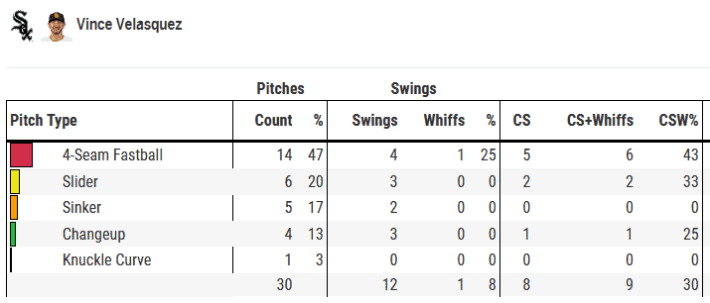Only one Cactus League park offers publicly available pitch-tracking info during spring training, which means that those who follow the White Sox are reliant on games at Salt River Fields to know how well their pitchers are throwing.
One or two games of data isn't ideal, and that small sample is even harder to parse when a game against the Diamondbacks or Rockies shows up at the top of the spring schedule, because we don't have much of a context for the evolution of a pitcher's velocity over the course of a spring.
I probably wouldn't have even remembered to seek it out had Vince Velasquez not made his debut in a White Sox uniform against the Rockies on Sunday -- albeit a White Sox uniform sporting three different logos, and a cap that scorches the Arizona State Flag onto bald guys. Given that his profile is fastball-dependent, I wanted to see exactly what that fastball did. He topped out at 95 and averaged 94, which is a little above where he sat last year, albeit over just 14 heaters.
Then I looked down the page and saw Liam Hendriks missing two ticks in a scoreless inning during which he took a comebacker to his right hamstring, walked three and threw 32 pitches.

James Fegan referenced unimpressive spring velocity for Hendriks a couple of days ago ...
No one is panicking about Liam Hendriks throwing some 94 mph fastballs in his first spring game, for example, because spin efficiency and extension have been more reliable offseason indicators for the right-hander to monitor while building up. That, and Hendriks tends to benefit a little from situational intensity.
“I threw a bullpen last year where I was 94 mph before the game, and pitched that night and sat 98 mph,” Hendriks said prior to this week.
... and given the dearth of reliable spring data elsewhere, we kinda have to take everybody's unalarmed word for it at this point. Any concerns regarding Hendriks would make the combination of signing Joe Kelly and retaining Craig Kimbrel slightly less overkill, but Ken Rosenthal says the latter isn't for a lack of trying.
[The Braves] were focused on adding a reliever before the Correa sweepstakes reached a dramatic conclusion early Saturday morning, discussing a trade with the White Sox for Craig Kimbrel, then agreeing with Kenley Jansen on a one-year, $16 million free-agent contract late Friday night.
Whereas Hendriks needed 32 pitches for one inning, Velasquez only had to throw 30 to get through a pair of scoreless frames in the White Sox's 4-2 victory over Colorado. The desert makes it hard for a lot of pitchers to throw their best breaking stuff, and it might be doubly hard for a guy like Velasquez, who spent the entirety of his career training in Florida before this year.
Nevertheless, his pitch mix reflects his career to date, in that he threw three kinds of non-fastballs and didn't get a whiff on any of them.

It'll take a few looks -- including at least one extended one in a standard environment -- before we can even begin to draw conclusions. For the time being, he threw 20 of 30 pitches for strikes, which is good enough to reinforce his positive impressions of working with Ethan Katz thus far.
“To be honest, [he] kind of simplified a lot of stuff,” Velasquez said. “A lot of the weapons that I had are there, just a matter of incorporating it and when to utilize it. Having that conviction has always been there, it’s just [a] matter of executing. It’s always been execution. It’s just a matter of applying it now.
“I think the stuff that I have incorporated with my backside and just trying to recreate different mechanics to synch up everything with my lower half to my upper half and timing everything. … I create a lot of leverage going down the mound, I’m very whippy, very athletic. It’s just a matter of utilizing my athleticism and finding the consistency, and [Katz] does a good job of doing that and finding those areas.”
During a normal season, Velasquez and Reynaldo López would seem to be an either/or discussion, as they're both righties with fringe starting profiles due to a lack of a real go-to secondary pitch. With the shortened spring and a condensed regular-season schedule, they'll both likely be needed early on, especially since Michael Kopech is coming back from a late-winter bout of COVID-19.
Scott Merkin came through with a valuable article that details López's vision problems. It's a necessary read, especially for those of us -- and I'm raising my hand -- who didn't understand why López made such a big deal about his focus being his biggest hurdle. I suppose the problem was that we weren't taking him literally enough.
"That was difficult. I was feeling confused. I was hesitating a lot,” López told MLB.com, through interpreter Billy Russo, during a recent interview. “I wasn’t having the conviction that I usually have, and it happened a few times with [catcher Yasmani] Grandal.
“Sometimes he called a slider, and I was seeing fastball. Or sometimes he called fastball and I was throwing sliders. That was when I started feeling more afraid and hesitating more because I didn’t want to hurt anybody. But then after surgery, the improvement was noticeable. I was feeling way better, and I wasn’t having that problem. That was a big step forward.”
This explains why López kept stressing the mental part of his game as the biggest contributor to his problems, even though it's a less flattering excuse each time it's used. I figured it was because "I can't spin a dangerous breaking ball on a reliable basis" is just as unsatisfactory, and he theoretically has more control over how he thinks through the game. In this case, both issues can be traced back to physical limitations.
Another candidate for spot starts is Garrett Crochet, although the White Sox would probably prefer Velasquez and López to be depth enough, freeing up Crochet for more standard relief experiences on a reliable basis.
Crochet enters his second full season with everybody having a much better idea of what he has, for better or for worse. He appeared in Sunday's game and topped out at 97.4 mph, and he tells James Fegan that he's more or less at peace with the idea of his triple-digit heat never coming back ("I think about it from time to time, but I think that that’s just rat poison").
While Crochet came into the season with diminished velocity, he didn't really lose anything over a six-month season. With one successful grind under his belt, the idea is to expand what Crochet can do with what he has.
Shoehorning him into the niche Kopech created for himself might be asking too much, but it sounds like the White Sox will start with regular two-inning appearances, then see how he maintains his effectiveness.
“It’s a balancing act,” pitching coach Ethan Katz said. “It’s also to see how he recovers, because the way Michael recovers to how Garrett recovers (could be different). If he goes out there and throws three innings, we might be in trouble for three to four days and that could kill the ‘pen.”
But Crochet is expected to work multiple innings more, and build his innings base higher for the potential 120-plus innings any sort of future starter role would demand — which, to be clear, he is hoping will come next season. Just two innings, Crochet asserts, can be a step toward that.
“Going out there for a second inning after you come in the dugout is a totally different mindset,” Crochet said. “That’s very enticing to me, just the opportunity to get more innings and help the team out a little bit more. That’s an opportunity that I’ll never turn down. And something that I definitely look forward to, getting multiple innings out there. I think it will eventually help you transform into that starter role a lot more seamlessly.”





